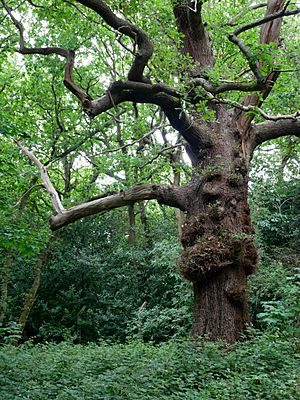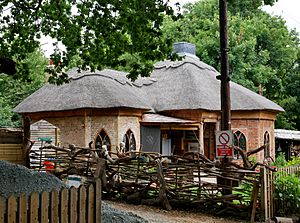Scadbury Park facts for kids
Scadbury Park is a wonderful place in Chislehurst, located in the London Borough of Bromley. It's a special area called a Local Nature Reserve, which means it's protected for its natural beauty and wildlife. It's also known as a Site of Metropolitan Importance for Nature Conservation, showing how important it is for nature across London.
This park is huge, covering over 300 acres! It's part of a bigger natural pathway, like a green highway for animals, connecting with Petts Wood and the Jubilee Country Park. This helps wildlife move safely between different areas.
Scadbury Park has many old trees, especially oak trees, which have been growing there for a very long time. You can also find beautiful flowers like lily of the valley, which is quite rare to see in London. The ponds in the park are home to the largest group of protected great crested newts in London. These amazing creatures are very important to protect.
Much of the park has untouched grasslands, which are great for many different plants and animals. There's even a working farm within the park! You can enter Scadbury Park from Old Perry Street, where the old entrance pillars still stand. There's also a West Lodge building on Old Perry Street. A walking path called the London Loop goes right through the park, connecting different areas.
Contents
A Journey Through Time
Scadbury Park has a long and interesting history, stretching back many centuries. It was once a large estate called a manor.
Early Days of Scadbury
The first records of the manor date back to the 1200s. At that time, it was owned by a family known as de Scathebury. Imagine living in a place that has been around for so long!
In 1424, a wealthy merchant named Thomas Walsingham bought the manor. He was a successful businessman in London, dealing in wine and cloth. He even served as a Member of Parliament, which meant he helped make important decisions for the country.
Famous Connections
Scadbury Manor became the home of the Walsingham family for many years, until about 1655. Some very famous people were connected to this place. One was Sir Thomas Walsingham, who was a supporter of the famous writer Christopher Marlowe. Marlowe was even staying at Scadbury Manor just before he died in 1593.
Another important person born at Scadbury was Francis Walsingham. He was Queen Elizabeth I's spymaster, a very important job during her reign! He gathered secret information to protect the queen and the country.
Modern History
Later, in 1736, a man named Col. John Selwyn bought the property. He owned it for a few years before passing it to Thomas Townshend, 1st Viscount Sydney in 1742. You might recognize the name Sydney because the famous city of Sydney, Australia was named after him!
The London Borough of Bromley bought Scadbury Manor in 1983. They then opened it to the public in 1985, allowing everyone to enjoy its nature and history.
Images for kids






